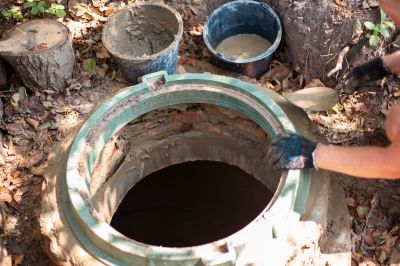Popular Solutions For Septic System Construction Projects
Discover top-rated materials and equipment that streamline septic system building processes for homeowners and professionals alike.
 Constructing a reliable septic system involves selecting the right components to ensure proper waste management and system longevity. Essential products include sewage tanks, distribution boxes, drain field components, and piping materials that work together to process and disperse wastewater effectively. When planning a septic system, it is important to consider the size of the property, anticipated usage, and local regulations to choose appropriate products that meet capacity and safety standards.
Constructing a reliable septic system involves selecting the right components to ensure proper waste management and system longevity. Essential products include sewage tanks, distribution boxes, drain field components, and piping materials that work together to process and disperse wastewater effectively. When planning a septic system, it is important to consider the size of the property, anticipated usage, and local regulations to choose appropriate products that meet capacity and safety standards.
Top Overall Option
Septic Tank System Components
A comprehensive septic tank system includes durable tanks, distribution boxes, and piping solutions designed for ease of installation and maintenance. These components are crafted from high-quality materials to withstand environmental conditions and provide long-term performance. When selecting a septic system, considering modular options and compatibility with local regulations can help ensure a smooth construction process and reliable operation.
Types of Products For Septic System Constructions
Septic Tanks
Primary containers for wastewater collection, available in various materials and sizes to suit different property needs.
Distribution Boxes
Devices that evenly distribute effluent from the septic tank to the drain field, ensuring balanced flow.
Drain Field Piping
Perforated and solid pipes designed for effective dispersal of effluent into the soil.
Septic Tank Risers and Lids
Access points that facilitate inspection, maintenance, and pumping of septic tanks.
Filter Accessories
Filters that prevent solids from entering drain fields, helping reduce clogs and system failures.
Piping Connectors and Fittings
Various fittings to connect pipes securely and ensure leak-proof joints in the septic system.
Gravel and Drain Field Bed Materials
Aggregate materials used to create effective drainage beds for wastewater dispersal.
Inspection Ports
Access points for monitoring and inspecting the septic system's condition.
Pump Systems
Pumps used in systems requiring lift stations or for moving wastewater in challenging terrains.
Tank Baffles and Dividers
Internal components that help prevent solids from exiting the tank and improve separation.
Popular Choices
Lightweight and resistant to corrosion, these tanks are easy to install and maintain.
Heavy-duty and durable, suitable for larger systems and long-term installations.
Affordable and simple to install, these boxes help distribute effluent evenly.
Designed to disperse wastewater uniformly across the drain field area.
Facilitate easy access for inspection and maintenance tasks.
Provides a stable base for drain pipes and promotes effective wastewater dispersal.
Various fittings for secure pipe connections and system integrity.
Assist in moving wastewater in systems where gravity flow is insufficient.
Help prevent solids from leaving the tank and entering the drain field.
Provide easy access for inspection and maintenance of septic tanks.
Prevent solids from clogging drain field components and improve system longevity.
Contain essential parts for minor repairs and system upgrades.
Septic tanks serve as the primary treatment units, collecting and temporarily holding wastewater before it is processed further. These tanks come in various sizes and materials, including concrete, plastic, and fiberglass, each offering different benefits in terms of durability and installation ease. Distribution boxes help evenly route effluent from the septic tank to the drain field, ensuring consistent flow and preventing system overloads. Drain field components, such as pipes and gravel beds, facilitate the absorption and filtration of effluent into the soil, which is a critical step in the treatment process.
Proper piping and fittings are vital for maintaining system integrity and preventing leaks or blockages. Perforated pipes are often used in drain fields to allow effluent to disperse uniformly, while solid pipes connect various system components securely. Additionally, access risers and lids are important for maintenance and inspection, providing convenient access points for routine checks. Selecting high-quality, compatible products is essential to ensure the system functions efficiently over time and complies with local codes and standards.
Key Buying Considerations
- Assess the size and capacity requirements based on household size and usage patterns.
- Select materials that are compatible with local soil and environmental conditions.
- Ensure the products meet local building codes and regulations for septic systems.
- Consider ease of installation and availability of professional services if needed.
- Evaluate the durability and lifespan of materials like plastic, concrete, or fiberglass.
- Check for compatibility between different system components to ensure seamless operation.
- Determine if additional features such as inspection ports or filters are necessary for maintenance.
- Review warranty options and manufacturer support for long-term peace of mind.
- Account for potential future expansions or upgrades in system planning.
- Consider the ease of access for routine inspections and pumping activities.
- Analyze the environmental suitability of piping and gravel materials for effective drainage.
- Factor in the local climate, especially freeze-thaw cycles that could impact system components.
- Budget for both initial installation costs and ongoing maintenance expenses.
- Research the availability of replacement parts and system accessories.
- Prioritize products with proven compatibility and positive user feedback.
